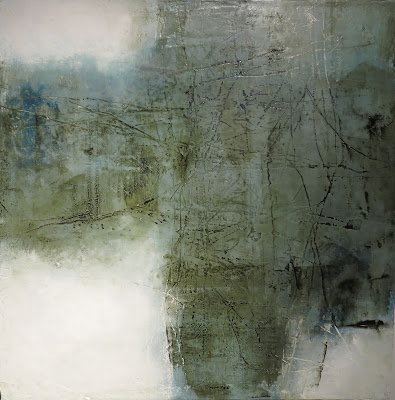 |
| Why I Love The Wind 16"x20" |
I was chopping vege for dinner one night with my daughter, who does some meditation coaching. "How's the painting going?" she asked.
"Oh, I don't know", I said. It seems like I move paint around on the canvas and never really like anything that turns up. It feels like I paint the same thing over and over and feel frustrated that I'm not getting anywhere." She looked at me and said, "hmm, that sounds like the same thing you said two years ago."
"That does sound about right," I said, appreciating the honesty and her willingness to share even though I had a knife in my hand.
"So you're not getting anything you like when you paint? Do you know what you like?" she asked
"I like something light. I like some scratching and texture. I like greens and blues and neutrals, greys, soft transitions from one colour to another. But I rarely seem to get something that pleases me."
 |
| 16"x 16" Coming In For A Landing |
"I wonder if you're seeing a painting as problem that you want solved and out of the way?" She pondered
"Hmm, that's true, I think. I want a satisfying outcome without too much trouble. And it feels like I've been at this for a long time without much reward. It's interesting, because this conversation makes me think of my friend
Jeane Myers over at Art It. I love the way she thinks! She really perks up when she has a creative problem to solve in a painting. That's juicy to her and she rises to the challenge. It really makes her curious and interested." (I also added inappropriately that I wanted her brain.)
"I also love that she says she learns from her paintings," I added. It seems I'm not the best student and my paintings have given up on me.
"So," said the coachy daughter, "what if you focused more on being curious about the process when you go to paint, rather than the actual painting.
 |
| 11"x14" How To Get From Here To There |
So I made some notes so I could share with you (and with me) and the next time I went to paint I tried to remember to:
-If you are used to thinking of your creative work as a problem or fraught with problems, sense how this feels and try to adopt a different stance.
-Be curious about how you work, watching what you do and how it makes you feel (miraculously I am a whole lot neater when I paint after doing this. Before I seemed to rush and a mess of brushes and paper grew around me. That made me feel unsettled as the chaos grew)
-Be curious about what emerges on the canvas. Take time to stand back a lot more than usual. Jeane talks about having a conversation with the painting. I think a lot of the time I don't give the painting enough space to say anything. I am like the friend that blathers on. Poor painting never gets a word in edgewise.
-Notice how you feel inside. When I felt agitated and tight, I found it was time to stop and refocus, otherwise I went on to mucking (which could go on for a very long time and feel very unsatisfying.) Sometimes it's just time to go for coffee, have a walk, take a break.
-Importantly, trust that you can solve any "creative situation" you find in front of you. (In other words, believe you are up to the task.) This, I found creates a very powerful, positive feeling.
-Contemplate situations in life where you are successful and try to transfer that attitude to painting. Do you write with ease, cook confidently? How do you feel inside when you trust that things are going to work out? Sometimes it's all about attitude. Maybe it's always, all about attitude?
-Sometimes just do the opposite of what you might normally do to shake things up. Do you always paint in a certain palette? Do the opposite. Stand up. Sit down. Use paper. Listen to music, or different music. Try silence or spoken word.
I have found it so helpful to consider the deeper aspects of what I was doing and how I was approaching it. I learned first hand how doing the same thing over and over is the definition of insanity (or at least frustration). I learned that focusing on the process, strangely creates a better outcome than focusing on the painting (or specific work at hand).
And I will end with a story that my coach/daughter told me about a yoga teacher that her friend called the "spiritual badger". As they stood holding a really difficult pose, he said, "and how you do this, is how you do everything in life." With many bows to the spiritual badger.
















